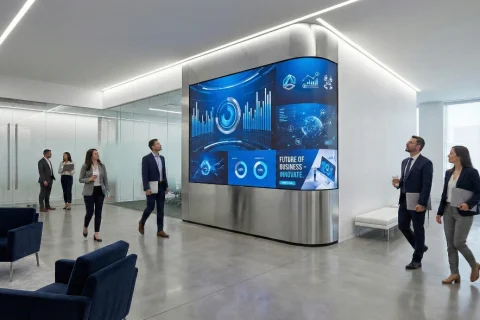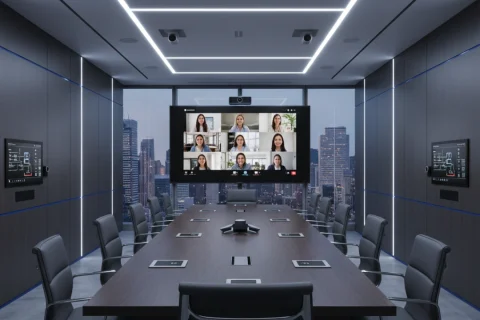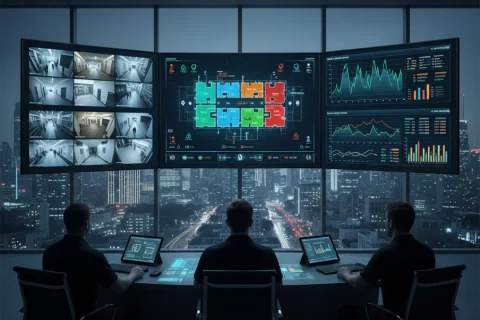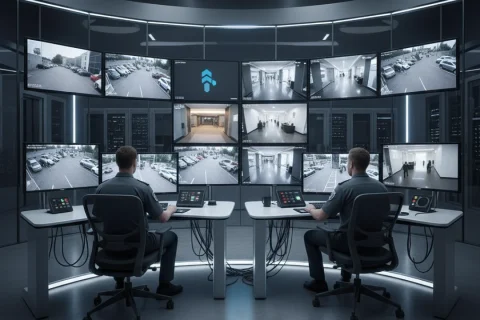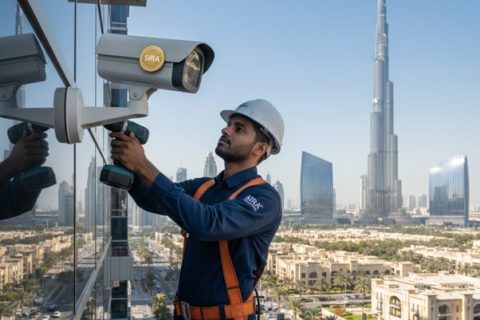Building owners and facility managers face mounting pressure to deliver smarter, more secure infrastructure. An ELV system for buildings offers the integrated solution needed to meet these demands while optimizing operational efficiency and reducing long-term costs. These extra low voltage systems form the technological backbone of modern commercial properties, connecting everything from access control to fire safety networks.
Key Takeaways
- ELV systems integrate multiple building technologies into unified platforms for enhanced security, efficiency, and operational control
- Modern commercial security cameras represent just one component of comprehensive ELV infrastructure that includes access control, fire safety, and communications
- Professional ELV implementation delivers 30-40% reduction in energy costs while improving building safety and occupant experience
- Strategic planning and expert installation ensure seamless integration with existing infrastructure and future scalability
What Makes ELV Systems Essential for Modern Buildings
An ELV system for buildings represents a comprehensive network of interconnected technologies operating at safe voltage levels below 50 volts AC or 120 volts DC. These systems handle critical building functions including security surveillance, access control, fire detection, public address systems, and structured cabling networks.
Unlike traditional building systems that operate independently, modern ELV infrastructure creates intelligent connections between different technologies. When a fire alarm system detects smoke, it can automatically trigger commercial security cameras to record evacuation routes, unlock emergency exits through access control systems, and broadcast evacuation instructions via public address networks. This level of integration transforms building operations from reactive to proactive management.
The demand for sophisticated ELV solutions continues accelerating across commercial real estate sectors. According to industry research, the global building automation market is projected to reach $121.5 billion by 2026, with ELV systems forming the foundational infrastructure. Property managers recognize that well-designed ELV architecture directly impacts property values, tenant satisfaction, and operational expenditures.
Core Components of ELV Infrastructure
Security and Surveillance Networks
Commercial security cameras serve as the visual intelligence layer within ELV ecosystems. Modern IP-based camera systems integrate with video management platforms to provide real-time monitoring, intelligent analytics, and forensic investigation capabilities. These systems utilize advanced features including facial recognition, perimeter intrusion detection, and behavioral analysis to enhance security protocols.
Access control systems work in tandem with surveillance networks to manage building entry points. Electronic locks, card readers, and biometric scanners create secure checkpoints while maintaining detailed audit trails of all access events. Integration between access control and commercial security cameras enables visual verification of entry attempts and immediate security responses to unauthorized access.
Intrusion detection systems add another security layer through motion sensors, glass break detectors, and door/window contacts. When integrated with surveillance and access control, these systems create comprehensive security coverage that adapts to different operational scenarios and threat levels.
Communication and Information Systems
Public address and voice alarm systems ensure clear communication during both routine operations and emergency situations. These systems broadcast announcements, background music, and emergency notifications through strategically positioned speakers. Integration with fire safety networks enables automatic emergency messaging when smoke detectors activate.
Structured cabling infrastructure provides the physical backbone connecting all ELV components. Modern Category 6A or fiber optic cabling supports high-bandwidth requirements for IP cameras, wireless access points, and building automation controllers. Proper cabling design ensures reliable connectivity and supports future technology upgrades.
Building management systems (BMS) serve as the central nervous system coordinating all ELV subsystems. These platforms provide unified interfaces for monitoring and controlling lighting, HVAC, security, and communications from single dashboards. Advanced BMS solutions utilize artificial intelligence to optimize building performance based on occupancy patterns and environmental conditions.
Fire Safety and Life Protection Systems
Fire detection and alarm systems represent critical life safety components within ELV architecture. Modern addressable fire panels pinpoint exact detector locations when smoke or heat is detected, enabling rapid response. Integration with building automation triggers coordinated responses including elevator recall, HVAC smoke control, and emergency lighting activation.
Emergency lighting systems ensure safe evacuation routes remain illuminated during power failures. These systems include exit signs, pathway lighting, and central battery systems that automatically activate when normal power fails. Regular testing and maintenance protocols verify system reliability when emergencies occur.
Strategic Benefits of Integrated ELV Implementation
Operational Efficiency and Cost Reduction
Integrated ELV systems deliver measurable operational improvements across multiple dimensions. Energy management capabilities reduce utility costs by 30-40% through intelligent lighting control, HVAC optimization, and equipment scheduling. Buildings with advanced ELV infrastructure typically achieve 20-25% lower maintenance costs compared to conventional systems.
Centralized monitoring reduces staffing requirements while improving response times to building events. Facility managers access real-time data from any location, enabling remote troubleshooting and reducing on-site visits. Predictive maintenance capabilities identify equipment issues before failures occur, minimizing costly emergency repairs.
Enhanced Security and Safety Compliance
Comprehensive ELV integration strengthens security postures through coordinated system responses. When perimeter intrusion is detected, the system automatically activates commercial security cameras in affected zones, illuminates pathways, and alerts security personnel with precise location data. This coordinated response dramatically reduces incident response times.
Regulatory compliance becomes simpler with integrated documentation and reporting capabilities. Systems automatically log all security events, access attempts, and maintenance activities. During audits or investigations, facility managers quickly retrieve detailed records demonstrating compliance with safety codes and security protocols.
Improved Occupant Experience and Property Value
Modern occupants expect smart building amenities that enhance comfort and productivity. Integrated ELV systems deliver personalized environmental controls, seamless wireless connectivity, and intuitive building navigation. These features increase tenant satisfaction and reduce vacancy rates.
Properties with advanced ELV infrastructure command premium rental rates and sale prices. According to commercial real estate data, buildings with certified smart building systems achieve 3-5% higher valuations compared to conventional properties. The investment in quality ELV infrastructure delivers strong returns through both operational savings and increased property values.
Essential Planning Considerations for ELV Implementation
Infrastructure Assessment and Design
Successful ELV implementation begins with comprehensive infrastructure assessment. Professional evaluations identify existing systems, infrastructure limitations, and integration opportunities. Detailed site surveys document cable pathways, equipment rooms, power availability, and environmental conditions affecting system performance.
Design specifications must address current requirements while accommodating future expansion. Scalable architecture supports phased implementation and technology upgrades without requiring complete system replacements. Industry standards including TIA-568 for structured cabling and ISO 7240 for fire detection guide proper system design.
Vendor Selection and System Integration
Selecting experienced ELV integrators significantly impacts project outcomes. Qualified vendors demonstrate proven expertise across multiple system types, hold relevant certifications, and provide comprehensive support services. Evaluate potential partners based on:
- Technical certifications from major manufacturers
- Portfolio of comparable project implementations
- In-house engineering and design capabilities
- Post-installation support and maintenance services
- Financial stability and industry reputation
Integration capabilities prove especially critical when connecting systems from multiple manufacturers. Professional ELV specialists utilize open protocols and middleware platforms to ensure seamless communication between diverse systems.
Installation Standards and Quality Control
Professional installation follows industry standards and manufacturer specifications to ensure system reliability. Proper cable management, equipment mounting, and environmental protection prevent performance issues and extend system lifespan. Quality control procedures including cable testing, device commissioning, and system validation verify that installations meet design specifications.
Documentation requirements include as-built drawings, equipment schedules, configuration files, and maintenance procedures. Comprehensive documentation enables efficient troubleshooting, supports system modifications, and ensures continuity when personnel changes occur.
Emerging Technologies Shaping ELV System Evolution
Artificial Intelligence and Analytics
Artificial intelligence transforms ELV systems from passive recording devices into proactive management tools. AI-powered video analytics detect unusual behaviors, count occupants, and analyze traffic patterns without human monitoring. These insights optimize space utilization, improve security responses, and inform facility planning decisions.
Machine learning algorithms continuously improve system performance by analyzing historical data and adapting to building patterns. Predictive maintenance capabilities identify equipment degradation before failures occur, scheduling interventions during planned maintenance windows rather than responding to emergency breakdowns.
Cloud Integration and Remote Management
Cloud-based ELV platforms eliminate traditional on-premise server requirements while enabling remote system management. Facility managers access building systems from any internet-connected device, reviewing live camera feeds, adjusting access permissions, and monitoring system health. Cloud storage provides scalable video retention without expensive on-site recording infrastructure.
Software-as-a-service models reduce upfront capital expenditures by converting ELV infrastructure to operational expenses. Automatic software updates ensure systems maintain current features and security patches without manual intervention. Multi-site organizations benefit from centralized management platforms that provide unified visibility across entire property portfolios.
Internet of Things and Sensor Networks
IoT sensors expand ELV capabilities beyond traditional security and life safety applications. Environmental sensors monitor air quality, temperature, humidity, and light levels to optimize occupant comfort and energy efficiency. Occupancy sensors provide real-time space utilization data that informs workplace strategies and resource allocation.
Integration between IoT sensors and building automation creates responsive environments that adapt to changing conditions. When meeting rooms are occupied, systems automatically adjust lighting and temperature while ensuring proper security protocols are maintained. These intelligent responses enhance experiences while optimizing resource consumption.
Implementation Best Practices and Common Pitfalls
Project Planning and Stakeholder Alignment
Successful ELV projects require clear objectives and stakeholder buy-in from project inception. Define specific goals including security requirements, operational metrics, budget parameters, and implementation timelines. Engage all affected parties including facility managers, IT departments, security teams, and executive leadership to ensure comprehensive requirements capture.
Establish realistic timelines that account for design development, equipment procurement, installation coordination, and system commissioning. Complex installations in occupied buildings require phased approaches that minimize operational disruptions. Build contingency buffers into schedules to accommodate unforeseen challenges.
Budget Development and Lifecycle Costs
Comprehensive budgets extend beyond initial equipment and installation costs to include ongoing operational expenses. Factor in software licensing, maintenance agreements, training programs, and periodic upgrades. Total cost of ownership analysis over 10-15 year periods provides accurate financial projections.
Value engineering identifies cost savings opportunities without compromising functionality or future scalability. Prioritize core capabilities that deliver immediate benefits while phasing optional features into future budget cycles. Avoid false economies that create technical debt or require premature system replacements.
Training and Change Management
User adoption determines whether sophisticated ELV systems deliver their full potential value. Comprehensive training programs ensure operators understand system capabilities and utilize available features effectively. Develop role-specific training modules for different user groups including security personnel, facility managers, and executive users.
Change management strategies address resistance to new technologies and workflows. Communicate benefits clearly, provide ongoing support resources, and gather user feedback to refine system configurations. Champions within user groups accelerate adoption by demonstrating practical applications and success stories.
Conclusion
An effective ELV system for buildings represents far more than security infrastructure, it creates the intelligent foundation enabling modern building operations. From commercial security cameras providing visual intelligence to integrated fire safety networks ensuring occupant protection, these systems work together to optimize building performance, reduce operational costs, and enhance user experiences.
Organizations investing in professional ELV implementation gain competitive advantages through improved efficiency, enhanced security, and increased property values. As buildings continue evolving toward fully integrated smart infrastructure, the role of comprehensive ELV systems becomes increasingly central to successful facility management.
Ready to transform your building with integrated ELV solutions? Contact Vega Digital IT Solutions to discuss how our expertise in smart infrastructure can optimize your facility operations and enhance your security posture.
Frequently Asked Questions
What is an ELV system for buildings?
An ELV system for buildings is a low-voltage network integrating security, fire safety, communications, and automation. Operating below 50V AC, these systems enhance safety, reduce energy costs, and enable centralized building management through interconnected technologies.
How do commercial security cameras work in ELV systems?
Commercial security cameras serve as visual intelligence within ELV systems, connecting with access control, fire alarms, and building automation. IP-based cameras provide real-time monitoring, AI analytics, and automated alerts for comprehensive security coverage.
What are the benefits of installing an ELV system for buildings?
ELV systems deliver 30-40% energy savings, enhanced security through integrated responses, improved occupant comfort, and 20-25% lower maintenance costs. They increase property values by 3-5% while providing centralized control of all building technologies.
Can small businesses afford an ELV system for building installation?
Yes, ELV systems scale to any budget and building size. Cloud-based solutions reduce infrastructure costs, while phased implementations allow businesses to start with essential security and expand gradually. ROI typically occurs within 3-5 years through operational savings.
What components are included in a complete ELV system?
Complete ELV systems include commercial security cameras, access control, fire detection, public address networks, structured cabling, building automation platforms, and emergency lighting. These components integrate through centralized management software for coordinated building operations.
How long does an ELV system for building implementations take?
Small ELV installations complete in 4-6 weeks, while comprehensive systems require 3-6 months. Timeline includes design, equipment procurement, installation, testing, and commissioning. Professional integrators minimize disruptions through phased implementation approaches.
What maintenance do commercial security cameras and ELV systems need?
ELV systems require quarterly inspections, annual testing, firmware updates, and battery replacements. Modern systems offer predictive maintenance, identifying issues before failures occur. Regular maintenance programs ensure optimal performance and extend equipment lifespan significantly.
Are ELV systems compatible with existing building infrastructure?
Modern ELV systems integrate seamlessly with existing infrastructure through open protocols and middleware platforms. Professional assessments identify compatibility requirements, enabling gradual upgrades without complete system replacements or major operational disruptions to building functions.
What is the difference between ELV and traditional building systems?
Traditional systems operate independently with separate controls. ELV systems integrate all functions such as security, HVAC, lighting, communications into unified platforms with automated, coordinated responses. This integration improves efficiency, reduces costs, and enhances safety through synchronized system actions.
How do you choose the right ELV system for building providers?
Select providers with manufacturer certifications, proven project portfolios, comprehensive support services, and relevant industry experience. Evaluate technical expertise, integration capabilities, post-installation support, and financial stability to ensure successful long-term system performance and reliability.

